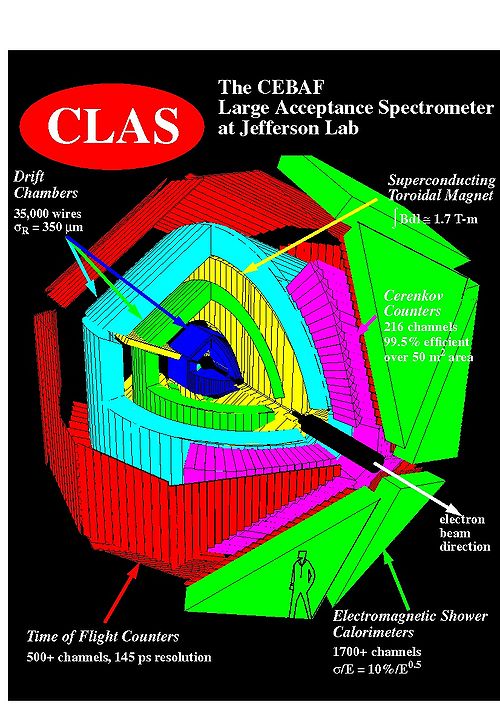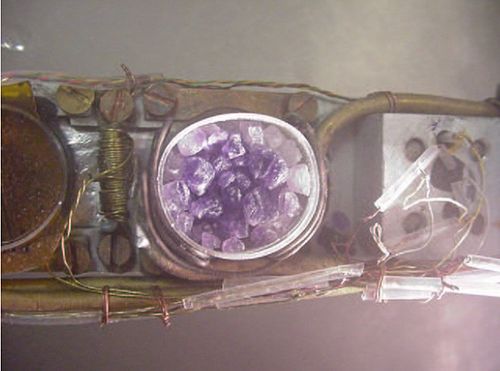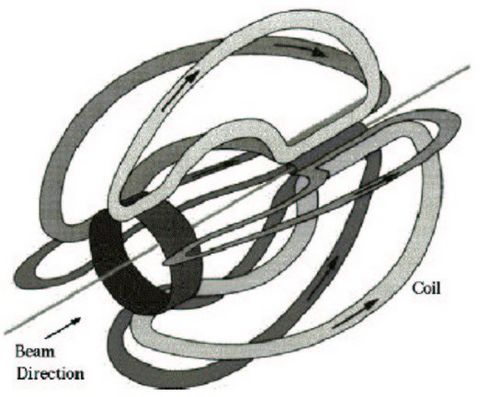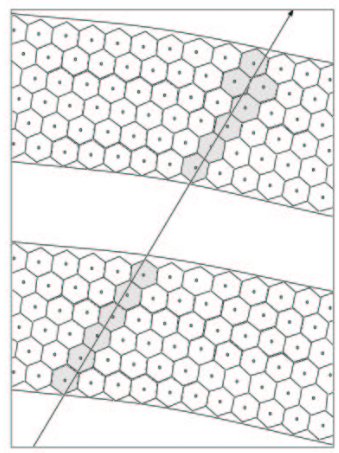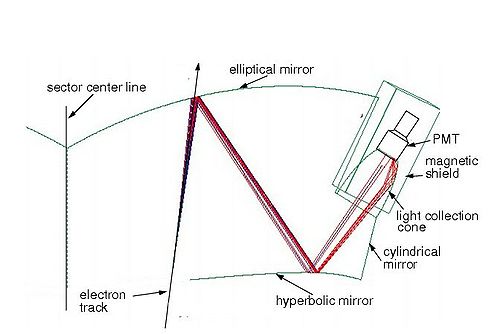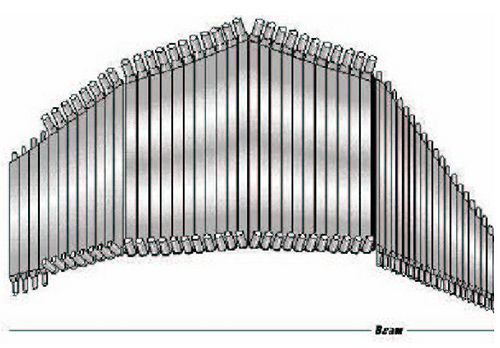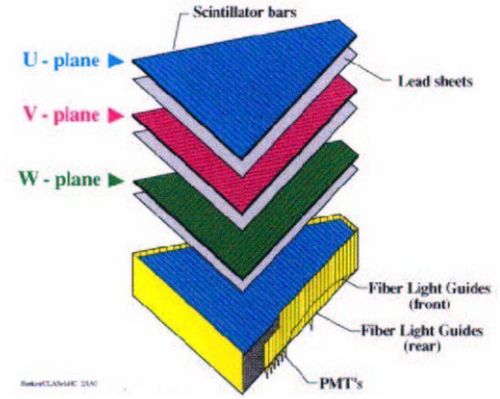Difference between revisions of "Tamar Thesis EperimentalSetupChapt"
| Line 16: | Line 16: | ||
The main target materials for the experiment used frozen ammonia, <math>^{15}NH_3</math>, for the polarized protons and deuterated ammonia, <math>^{15}ND_3</math> for the polarized deuterons. A target ladder, placed 50 cm upstream of the standard CLAS target position, was used to position the desired target. The target ladder was designed and built in collaboration with the Italian Istituto di Fisica Nucleare, TJNAF, Oxford instruments and the University of Virginia. The NH3 and ND3 targets were polarized using the method of Dynamic Nuclear Polarization(DNP) achieving the average beam-target polarization product of <math>P_b \times P_t = (0.51 \pm 0.01)</math> and <math>P_b \times P_t = (0.19 \pm 0.03)</math> respectively. <ref name="Dharmawardane2006"> Dharmawardane, K.V., et al., (The CLAS Collaboration). (2006). Measurement of the x and <math>Q^2</math>-Dependence of the Spin Asymmetry A1 on the Nucleon. ''Phys. Lett., B''(641), 11.</ref> Three other targets, <math>C_{12}</math>, liquid <math>He_{4}</math> and solid <math>N_{15}</math> were used to remove the Nitrogen and Helium background from the <math>NH_3</math> and <math>ND_3</math> target data. Liquid Helium was used to cool the ammonia targets. | The main target materials for the experiment used frozen ammonia, <math>^{15}NH_3</math>, for the polarized protons and deuterated ammonia, <math>^{15}ND_3</math> for the polarized deuterons. A target ladder, placed 50 cm upstream of the standard CLAS target position, was used to position the desired target. The target ladder was designed and built in collaboration with the Italian Istituto di Fisica Nucleare, TJNAF, Oxford instruments and the University of Virginia. The NH3 and ND3 targets were polarized using the method of Dynamic Nuclear Polarization(DNP) achieving the average beam-target polarization product of <math>P_b \times P_t = (0.51 \pm 0.01)</math> and <math>P_b \times P_t = (0.19 \pm 0.03)</math> respectively. <ref name="Dharmawardane2006"> Dharmawardane, K.V., et al., (The CLAS Collaboration). (2006). Measurement of the x and <math>Q^2</math>-Dependence of the Spin Asymmetry A1 on the Nucleon. ''Phys. Lett., B''(641), 11.</ref> Three other targets, <math>C_{12}</math>, liquid <math>He_{4}</math> and solid <math>N_{15}</math> were used to remove the Nitrogen and Helium background from the <math>NH_3</math> and <math>ND_3</math> target data. Liquid Helium was used to cool the ammonia targets. | ||
| − | Dynamic Nuclear Polarization (DNP) is a process in which the polarization of free electrons is transferred to a nucleus<ref name="Chen2006">Chen, S. (2006). ''First Measurement of Deeply Virtual Compton Scattering with a Polarized Proton Target''. Doctoral dissertation. Florida State University, Tallahasee, FL. </ref> . In DNP the target is doped with paramagnetic impurities by chemical doping or by irradiating the target in an electron beam. For low temperatures, on the order of <math>0.5 K</math> and high magnetic fields on the order of 2.5 <math>\mbox{Tesla}</math>, the free electron polarization approaches 100%, on the other hand the protons inside the target are unpolarized. An applied microwave field with a frequency close to the electron spin resonance induces transitions which flip the spin of the electron and, because of the electron-nucleus hyperfine | + | Dynamic Nuclear Polarization (DNP) is a process in which the polarization of free electrons is transferred to a nucleus<ref name="Chen2006">Chen, S. (2006). ''First Measurement of Deeply Virtual Compton Scattering with a Polarized Proton Target''. Doctoral dissertation. Florida State University, Tallahasee, FL. </ref> . In DNP the target is doped with paramagnetic impurities by chemical doping or by irradiating the target in an electron beam. For low temperatures, on the order of <math>0.5 K</math> and high magnetic fields on the order of 2.5 <math>\mbox{Tesla}</math>, the free electron polarization approaches 100%, on the other hand the protons inside the target are unpolarized. An applied microwave field with a frequency close to the electron spin resonance induces transitions which flip the spin of the electron and, because of the electron-nucleus hyperfine couping, a nearby proton. The relaxation time of the electron is <math>10^{-3} s</math>, whereas the relaxation time of the proton in the target is <math>10^3 s</math>. Due to such a big difference of the relaxation time of the proton and electron, the flipped electron spin rapidly returns to its thermal equilibrium state from where it induces a proton spin-flip again. As a result, the spin polarization is transferred to the protons after some time. |
Ammonia targets were selected because of their ability to produce high polarization and sensitivity to high radiation dose by the incident electron beam radiation. The damage caused by this radiation can be repaired by annealing. The target is warmed up to liquid nitrogen temperature for annealing. In addition, the ammonia target has a high ratio of free nucleons (~3/18) approximately 16.7 % for <math>^{15}NH_3</math> and 28.6% for <math>^{15}ND_3</math>. One disadvantage of choosing ammonia is the polarization background caused by <math>^{15}N</math>(spin - 1/2), or <math>^{14}N</math>(spin - 1), which was accounted for by taking data using a solid <math>^{15}N</math> target <ref name="Keith2003"> Keith, C. D., et al. (2003). A Polarized target for the CLAS detector. ''NIM, A''(501), 327-339. 327-339.</ref> <ref name="Chen2006">Chen, S. (2006). ''First Measurement of Deeply Virtual Compton Scattering with a Polarized Proton Target''. Doctoral dissertation. Florida State University, Tallahasee, FL. </ref> . | Ammonia targets were selected because of their ability to produce high polarization and sensitivity to high radiation dose by the incident electron beam radiation. The damage caused by this radiation can be repaired by annealing. The target is warmed up to liquid nitrogen temperature for annealing. In addition, the ammonia target has a high ratio of free nucleons (~3/18) approximately 16.7 % for <math>^{15}NH_3</math> and 28.6% for <math>^{15}ND_3</math>. One disadvantage of choosing ammonia is the polarization background caused by <math>^{15}N</math>(spin - 1/2), or <math>^{14}N</math>(spin - 1), which was accounted for by taking data using a solid <math>^{15}N</math> target <ref name="Keith2003"> Keith, C. D., et al. (2003). A Polarized target for the CLAS detector. ''NIM, A''(501), 327-339. 327-339.</ref> <ref name="Chen2006">Chen, S. (2006). ''First Measurement of Deeply Virtual Compton Scattering with a Polarized Proton Target''. Doctoral dissertation. Florida State University, Tallahasee, FL. </ref> . | ||
Revision as of 04:09, 21 March 2011
The CEBAF Large Acceptance Spectrometer (CLAS), located in Jefferson Lab's Hall B, was used to measure the final state particles resulting from the scattering of a polarized electron by a polarized nucleon. The CLAS uses six superconducting coils to establish a toroidal magnetic field encircling the incident electron's momentum direction. A set of three drift chambers are positioned to determine the trajectories of particles which pass through the 6 gaps between the magnet coils. The first drift chamber, Region 1 (R1), is placed at the entrance to the magnetic coil. A second chamber, Region 2 (R2), is placed in the center of the coils. The final chamber, Region 3 (R3), measures charged particles leaving the toroidal field. A total of 18 drift chambers are available to reconstruct the trajectory of charged particles passing through the magnetic field. After the drift chamber system, the CLAS detector is equipped with a Cherenkov counter for separating electrons from pions and with scintillators, to determine the time of flight of a charged particle. An electromagnetic calorimeter is placed at the exit of the detector to detect neutral particles and improve the detector's ability to distinguish between electrons and hadrons.
Target
Target Materials
Five different targets were used during the EG1 experiment: , , , liquid and solid . <ref name="Keith2003"> Keith, C. D., et al. (2003). A Polarized target for the CLAS detector. NIM, A(501), 327-339. 327-339.</ref> The last three targets were used to estimate the dilution of signal events by background events which can be attributed to the interaction of the incident electron with the Nitrogen or Helium nucleons present in the target cell. This estimate is referred to as a dilution factor.
The main target materials for the experiment used frozen ammonia, , for the polarized protons and deuterated ammonia, for the polarized deuterons. A target ladder, placed 50 cm upstream of the standard CLAS target position, was used to position the desired target. The target ladder was designed and built in collaboration with the Italian Istituto di Fisica Nucleare, TJNAF, Oxford instruments and the University of Virginia. The NH3 and ND3 targets were polarized using the method of Dynamic Nuclear Polarization(DNP) achieving the average beam-target polarization product of and respectively. <ref name="Dharmawardane2006"> Dharmawardane, K.V., et al., (The CLAS Collaboration). (2006). Measurement of the x and -Dependence of the Spin Asymmetry A1 on the Nucleon. Phys. Lett., B(641), 11.</ref> Three other targets, , liquid and solid were used to remove the Nitrogen and Helium background from the and target data. Liquid Helium was used to cool the ammonia targets.
Dynamic Nuclear Polarization (DNP) is a process in which the polarization of free electrons is transferred to a nucleus<ref name="Chen2006">Chen, S. (2006). First Measurement of Deeply Virtual Compton Scattering with a Polarized Proton Target. Doctoral dissertation. Florida State University, Tallahasee, FL. </ref> . In DNP the target is doped with paramagnetic impurities by chemical doping or by irradiating the target in an electron beam. For low temperatures, on the order of and high magnetic fields on the order of 2.5 , the free electron polarization approaches 100%, on the other hand the protons inside the target are unpolarized. An applied microwave field with a frequency close to the electron spin resonance induces transitions which flip the spin of the electron and, because of the electron-nucleus hyperfine couping, a nearby proton. The relaxation time of the electron is , whereas the relaxation time of the proton in the target is . Due to such a big difference of the relaxation time of the proton and electron, the flipped electron spin rapidly returns to its thermal equilibrium state from where it induces a proton spin-flip again. As a result, the spin polarization is transferred to the protons after some time.
Ammonia targets were selected because of their ability to produce high polarization and sensitivity to high radiation dose by the incident electron beam radiation. The damage caused by this radiation can be repaired by annealing. The target is warmed up to liquid nitrogen temperature for annealing. In addition, the ammonia target has a high ratio of free nucleons (~3/18) approximately 16.7 % for and 28.6% for . One disadvantage of choosing ammonia is the polarization background caused by (spin - 1/2), or (spin - 1), which was accounted for by taking data using a solid target <ref name="Keith2003"> Keith, C. D., et al. (2003). A Polarized target for the CLAS detector. NIM, A(501), 327-339. 327-339.</ref> <ref name="Chen2006">Chen, S. (2006). First Measurement of Deeply Virtual Compton Scattering with a Polarized Proton Target. Doctoral dissertation. Florida State University, Tallahasee, FL. </ref> .
Target Magnet
A 5 T magnetic field is established using a pair of superconducting Helmholtz coils oriented such that the magnetic field is parallel to the incident beam direction. The field induces the hyperfine splittings needed to polarize the target material using 140 Ghz RF waves. The uniformity of the field is varying less than over a cylindrical volume of 20 mm in diameter and length. This configuration is necessary for DNP. The particles with scattering angles between 0-50 degrees are detected in the CLAS as well as 75-105 degrees. The Helmholtz coils block particles scattering between 50 and 75 degrees. The target magnetic field does not interact with the electron beam, however, it is effective in shielding the drift chambers from low energy Moller electrons. The target field bends the scattered particles in the azimuthal direction and falls rapidly with distance as (). The effect of the magnetic field on the drift chambers is negligible <ref name="Chen2006">Chen, S. (2006). First Measurement of Deeply Virtual Compton Scattering with a Polarized Proton Target. Doctoral dissertation. Florida State University, Tallahasee, FL. </ref> .
The CEBAF Large Acceptance spectrometer
The Torus Magnet
The CLAS's torus magnet consists of six superconducting coils located around the beam line in a toroidal geometry, producing a magnetic field in the direction when the z-axis of a spherical coordinate system is aligned with the incident beam direction. A sector is defined based on the boundaries of each magnetic coil resulting in a total of six sectors. The maximum current for the CLAS magnet is 2860 Amps corresponding to a total magnetic field in the forward direction of 2.5 T-m and 0.6 T at a polar scattering angle of 90 degrees. The magnet itself is around 5 m in diameter and 5 m in length. The coils of the magnet are cooled by liquid helium circulating through cooling tubes at the magnet's superconducting temperature of 4.5 K <ref name="Prok2004"> Prok, Y. A. (2004). Measurement of The Spin Structure Function of The Proton in The Resonance Region. Doctoral dissertation. University of Virginia, Richmond, VA.</ref>. A charged particle's momentum is determined by the radius of curvature through the magnetic field to a resolution of from 0.5% to 1% <ref name="Fatemi2002">Fatemi, R. H. (2002). The Spin Structure of The Proton in The Resonance Region. Doctoral dissertation. University of Virginia, Sterling, VA. </ref>. In the EG1b experiment, the operated torus values were: 2250, -2250, 1500, -1500 Amps.
Drift Chambers
The drift chamber system in the CLAS detector is divided into three regions, each consisting of six separate chambers(sectors). The drift chambers contain three types of wires stretched between the endplates: sense, guard and field. The end plates are attached to the drift chamber so that the angle they form is equal to 60 degrees. Each drift chamber is subdivided into two separate superlayers. Each superlayer has six layers of drift cells. Each drift cell has one sense wire and is surrounded by six field wires forming a hexagonal shape. Each superlayer is surrounded by guard wires at a positive potential to complete the cell symmetry establishing a radial electric field within the drift cells. The sense wire is operated at positive potential and the field wire at negative. In each superlayer the distance between the sense and field wire increases with the radial distance from the target. In R1 the average distance between the sense and field is 0.7 cm, in R2 1.15 cm, and in R3 2.0 cm <ref name="Metayer2000"> Mestayer, M. D., et. al. (2000). The CLAS drift chamber system. NIM, A(449), 81-111.</ref> . The CLAS drift chamber gas is a 90 - 10% mixture of the argon(Ar) and , where Ar has an ionization gain of . Inside the drift chamber, a constant pressure is provided by outflowing the gas. The chamber end plates have a circuit board with a single channel differential pre-amplifier for each sense wire.
The drift chamber system is used to track charged particles. A drift chamber is a particle tracking detector that measures the drift time of liberated electrons in a gas to calculate the spacial position of the ionizing particle.
An electric field in a drift chamber is produced by the anode(sense) and cathode(field) wires. A charged particle traveling through the drift chamber ionizes the gas, freeing electrons that drift to the anodes. After a drift time $(\delta t)$, electrons are collected at the anode(sense wire) generating a pulse for the time measurement. The distance of the traversing particle from the known position of the sense wire can be calculated using the drift time and drift velocity.
Cherenkov detector
The threshold CLAS Cherenkov detector is used to distinguish electrons from pions. The gas mixture used to fill the Cherenkov counter is perfluorobutane gas at atmospheric pressure. The advantage of perfluorobutane gas is its high index of refraction n=1.00153, which results in a high photon yield. The threshold for Cerenkov radiation can be written as , or for energies , where v is the charged particle velocity, n the index of refraction for the medium, c the speed of light and . In our case . Accordingly, one can calculate the energy threshold for different charged particles; for electrons it is 9 MeV and for pions 2.5 GeV. The Cherenkov detector was designed to maximize the coverage in each of the sectors up to an angle degrees <ref name="Adams2001"> Adams, G., Burkert, V. D., et al. (The CLAS Collaboration). (2001). The CLAS Cherenkov Detector. NIM, A(465), 414-427. </ref> .
Light is collected using a system of mirrors to focus the light onto cones which are connected to the Phillips XP4500B type photomultiplier tubes(PMTs). In the extreme regions of the spectrometer's angular acceptance, the number of detected photoelectrons is too low. To get acceptable efficiency in these regions, photomultiplier tubes were placed.
Scintillators
The CLAS is equipped with 288 scintillator counters. The scintillators are used to determine the time of flight for a charged particle and to determine coincidences between particles. The time of flight system has a time resolution at small polar angles of ps and ps at angles above 90 degrees. This time resolution helps discriminate between pions and kaons up to 2 GeV/c. The time of flight system is located between the Cherenkov detectors and the electromagnetic calorimeters. The scintillator paddles are made from BC_408 <ref name="Adams2001"> Adams, G., Burkert, V. D., et al. (The CLAS Collaboration). (2001). The CLAS Cherenkov Detector. NIM, A(465), 414-427. </ref>, are located perpendicular to the average particle trajectory, and have an angular polar coverage of 1.5 degrees each. Each sector of the CLAS detector consists of 48 scintillator paddles with a thickness of 5.08 cm. The length of the scintillators varies from 30 cm to 450 cm and the width is between 15 cm at small polar angles and 22 cm for the large angles.
Calorimeter
The CLAS detector contains 8 electromagnetic calorimeter modules. A calorimeter measures the total energy deposited by a particle that enters the detectors acceptance. Calorimeters are sensitive neutral particles with sufficient energy to generate showers and can be used to distinguish between the energy deposited by electrons and hadrons. The CLAS calorimeter has three main functions:
1) detection of electrons at energies above 0.5 GeV;
2) detection of photons with energies higher than 0.2 GeV;
3) detection of neutrons, with discrimination between photon and neutrons using time-of-flight techniques.
Calorimeter detectors are placed in the forward region of each sector that span polar angles of 10-45 degrees. Two additional calorimeters are located in sectors 1 and 2 that span polar angles of 50 to 70 degrees. The forward calorimeter has a lead/scintillator thickness ratio of 0.2, with 40 cm of scintillators and 8 cm of lead per module. The lead-scintillator sandwich is shaped to form an equilateral triangle in order to match the hexagonal geometry of the CLAS detector. Each scintillator layer contains 36 paddles parallel to one side of the triangle, with this configuration each orientation is rotated by 120 degrees from each other. This gives three views, each containing 13 layers providing stereo information locating the energy deposition. There is a longitudinal sampling of the shower to improve hadron identification. Each set of 13 layers are subdivided into 5 inner layers and 8 outer layers.
Notes
<references/>
